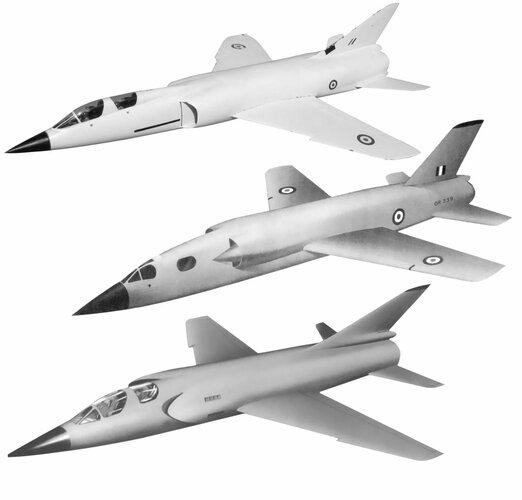12/53 ITP, (1 static+2) with Avon RA.24R, to RAE's preferred M2.25 Bomber layout. No benefit to Bristol when Avro 730 was chosen 11/55.
The layout was also RAE's preferred M2 Interceptor layout too for OR.329/F.155 which built on work done to ER.134T.
AWA had been runner up in 8/53 for ER.134 too with the AW.66 (2x Sapphire Sa.7, 1st Proto all light alloy, 2nd proto with steel wing), losing out to Bristol due to their Javelin commitments but picking up sub-contract work on Type 188.
The three additional 188s were linked to OR.329 and OR.330, but the latter OR seems to have overtaken the design requirements for Type 188. Ironically AWA came runner up again with the AW.169 for F.155, which of course had 4x Gyron Juniors but was cancelled in 11/56 (reluctance by MoS to let AWA build a fighter development team there). AW.69 was designed for M2.0 but AWA felt M2.7 could be reached and that M3.0 was possible with stainless steel construction and higher-thrust engines.
So some further questions:
1) Did ER.134 have any purpose beyond supporting OR.330 given the F.155 interceptors mostly replicated ER.134 in terms of performance, beyond the obvious differences in stainless steel construction?
2) Had AW.66 gone ahead would this have clinched the AW.69 for F.155?
3) If AW.69 had gone ahead and F.155 still fallen to Sandys axe, would the prototypes have been saved to serve as Gyron Junior testbeds?
4) If the answer to 3 is yes, would that mean the end for Type 188 given the Avro 730 and its P.176 engines were dead? Maybe AWA is told to go ahead and build a stainless steel M3.0 AW.69...
I can't help feeling ER.134 was always a programme looking for rationales to exist, giving minor players like Bristol and AWA some work to do while the big firms got on with the real ORs like 329 and 330 which ER.134 played some minor role in the initial design stages but which as flying hardware could have barely given any practical support given those ORs were only 1-2 years behind ER.134. As Ken points out the dithering cost 8 years, certainly had F.155 gone ahead it would have been entering service by 1962 and the Avro 730 would certainly have been flying in prototype form by then.

